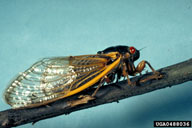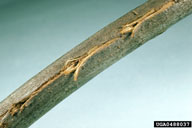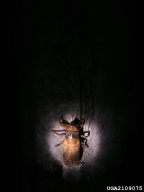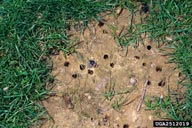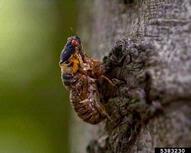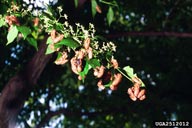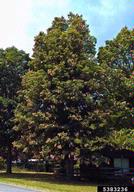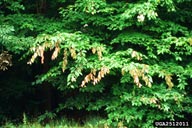Periodical cicada
Magicicada septendecim L. (Hemiptera: Cicadidae)
Orientation to pest
The periodical cicada, Magicicada septendecim L., is the largest of periodicallyemerging cicada species (adult, 40 mm in length). Females are black on top and males are black with a pattern of 4 or 5 orange-brown abdominal segments when viewed from below. The female has a stout ovipositor that is used to insert eggs into the bark of small branches and twigs. Eggs are laid in batches of 25-30, and many batches may be laid in the same twig. After eggs hatch, nymphs drop to the ground and burrow into the soil, where they feed on the plant's roots. Nymphs require 17 years to complete their development. Emergence of last instar nymphs is synchronous, producing mass swarms of adults at 17-year intervals. Broods (populations in different areas) are not necessarily in synchrony. Effect of nymphal feeding on roots has not been quantified. The only significant injury caused by this insect is the dieback of small branches ("flagging") from the cuts made for oviposition. While this injury can be highly visible it is not harmful to larger trees and shrubs since it only occurs every 17 years and large plants can tolerate this level of damage. On smaller trees, however, extensive oviposition may be harmful. Homeowners who need to protect small trees and shrubs from damage can do so by covering plants with netting to exclude cicadas, which should be left in place until most cicadas have died off (about four weeks from their first appearance). Periodical cicadas are often too numerous to make applications of pesticides practical. The mass emergences of this insect are much appreciated as a wildlife phenomenon and this species is best viewed as an impressive act of nature rather than as a pest.
Hosts commonly attacked
This cicada lays its eggs in more than 70 species of trees or other plants, but the most affected trees are oaks (Quercus), hickory (Carya), honeylocust (Gleditsia triacanthos L.) dogwood (Cornus), apple (Malus domestica Borkh.), and peach (Prunus persica [L.] Batsch.). But many other species may also be attacked at times.
Distribution
Magicicada septendecim is widely distributed in the eastern United States.
Images of the periodical cicada
| Figure 1. Adult of the periodical cicada, Magicicada septendecim, a 17-yr cicada | Figure 2. Oviposition scars made by the periodical cicada in a branch | Figure 3. Nymph of periodical cicada, the below-ground life stage | Figure 4. Holes in soil made by emerging last instar nymphs of the periodical cicada |
| Figure 5. Adult of a periodical cicada as it begins to molt from the last nymphal instar after its emergence from the soil | Figure 6. Cast skins of periodical cicada nymphs produced during the insect's mass emergence | Figure 7. Flagging of branches due to oviposition wounds of periodical cicada | Figure 8. Close up of branch flagging from oviposition wounds of periodical cicada |
Important biological control agents related to this pest species
Almost everything seems to eat periodical cicadas including birds, squirrels, snakes, spiders, etc. The massive populations of periodical cicadas, however, are able to satiate such predators and they appear to have little effect in reducing cicada densities.
Web links for information on the periodical cicada
- Periodical Cicada Page | The University of Michigan Museum of Zoology
Discussion on the various species of periodical cicadas - Sound files of cicada songs | magicicada.org
Articles
- Miller, F. D. 1997. Effects and control of periodical cicada Magicicada septendecim and Magicicada cassini oviposition injury on urban forest trees. Journal of Arboriculture 23(6): 225-232.
- Miller, F. and W. Crowley. 1998. Effects of periodical cicada ovipositional injury on woody plants. Journal of Arboriculture 24(5): 248-253.
